
The Zygaenidae moths are a family of Lepidoptera. The majority of zygaenids are tropical, but they are nevertheless quite well represented in temperate regions. Some of the 1000 or so species are commonly known as burnet or forester moths, often qualified by the number of spots, although other families also have 'foresters'. They are also sometimes called smoky moths.

Nyctemera is a genus of tiger moths in the family Erebidae first described by Jacob Hübner in 1820. The genus includes the species Nyctemera annulata and Nyctemera amica, which are closely related and are able to interbreed.

Urodidae, whose species are commonly known as false burnet moths, is a family of moths in the lepidopteran order. It is the type genus in the superfamily, Urodoidea, with three genera, one of which, Wockia, occurs in Europe.
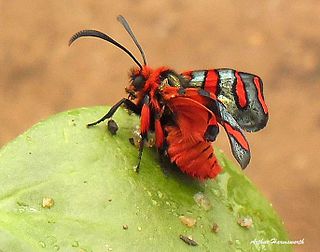
The fire grid burnet is a day-flying moth of the family Zygaenidae found in Zimbabwe and Malawi to Mozambique and South Africa.
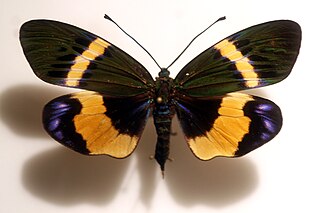
Chalcosiinae is a subfamily of the Zygaenidae, containing many species, mostly little known. Prominent sexual dimorphism, bright aposematic coloration and mimicry complexes are widespread.
Haplonerita is a genus of moths in the family Erebidae. It was first described by Walter Rothschild in 1909. The genus was erected by George Hampson in 1911.
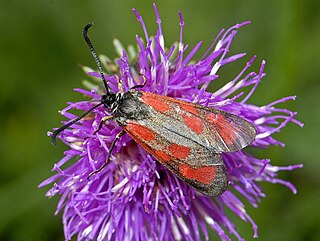
Zygaena loti, the slender Scotch burnet, is a moth of the family Zygaenidae. It is a diurnal moth characterized by a black body, light colored legs, and red spots on its wings. The caterpillars are a yellow-green color and usually molt out of dormancy in late February to early March. The larvae feed on plants from the family Fabaceae until they enter their pupal stage and mature into adults in May to early June. For mating, Zygaenidae exhibit a dual-partner finding strategy, where females use pheromones while assuming a calling position, and males exhibit a patrolling behavior where they utilize both vision and the olfactory receptors in their antennae to locate a potential mate. Although regionally endangered as their population is declining, Z. loti is found all across Europe, inhabiting areas rich in their desired food plants: lime-rich, and characterized by a hot and dry climate. The decreases in their population are likely due to factors such as habitat loss and fragmentation brought on by commercial agriculture and urbanization, as well as global climate change. There are few conservation programs currently focusing on Zygaena loti.
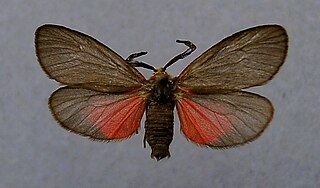
Aglaope infausta, or almond-tree leaf skeletonizer moth, is a moth of the family Zygaenidae.

Rhagades is a genus of moths of the family Zygaenidae. The genus was erected by Hans Daniel Johan Wallengren in 1863.
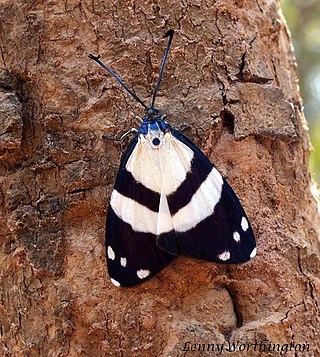
Corma is a genus of moths of the Zygaenidae family.
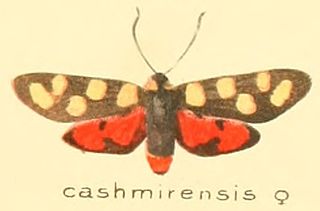
Praezygaena caschmirensis is a species of moth in the family Zygaenidae. It is found from Afghanistan to Nepal.

Cyclosia panthona is a moth in the family Zygaenidae. It was described by Caspar Stoll in 1780. It is found in China, Hong Kong, India, Sri Lanka, and Myanmar.
Milleria hamiltoni is a moth in the family Zygaenidae first described by Charles Swinhoe in 1891. It is mainly found in the Khasi Hills of Meghalaya, India.

Gaeana is a genus of cicadas, most members of which have colourful marking on their forewings, found across tropical and temperate Asia. Their bright wing patterns have been hypothesized as being a case of Batesian mimicry where the toxic models may be day-flying moths of the subfamilies Zygaeninae and Arctiinae. It is closely related to the genus Tosena but is differentiated by the exposed tympanum and lacks spines on the sides of the pronotum.
Clemensia maculata is a moth of the family Erebidae. It is found in Peru.
Gymnelia buckleyi is a moth of the subfamily Arctiinae. It was described by Herbert Druce in 1883. It is found in Ecuador.
Cerodendra quadripunctata is a moth in the family Zygaenidae. It was described by George Hampson in 1893 from Sri Lanka.
Corma fragilis is a species of moth in the family Zygaenidae. It is known from Sumatra and Borneo.
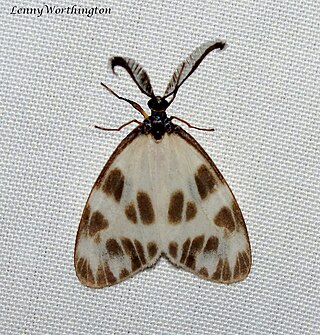
Corma zenotia is a species of moth in the family Zygaenidae.













